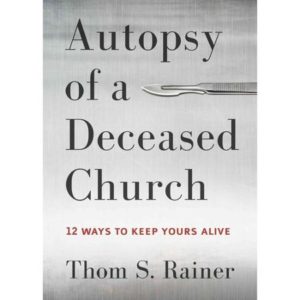 From Thom Rainer’s book, Autopsy of a Deceased Church, the author lists some tell-tale signs to alert us that our church is in trouble. Here are the most telling, in my opinion:
From Thom Rainer’s book, Autopsy of a Deceased Church, the author lists some tell-tale signs to alert us that our church is in trouble. Here are the most telling, in my opinion:
- “The church refused to look like the community. The community began a transition toward a lower socioeconomic class thirty years ago, but the church members had no desire to reach the new residents. The congregation thus became an island of middle-class members in a sea of lower-class residents.”
- “There was no attempt to reach the community.”
- “More and more emphasis was placed on the past.”
- “The percentage of the budget for members’ needs kept increasing. At the church’s death, the percentage was over 98 percent.”
- “As the church continued to decline toward death, the inward focus of the members turned caustic. Arguments were more frequent; business meetings became more acrimonious.”
- “The last three pastors were bi-vocational. All of the seven pastors left discouraged.”
- “The church rarely prayed together. In its last eight years, the only time of corporate prayer was a three-minute period in the Sunday worship service.”
- “The church had no clarity as to why it existed. There was no vision, no mission, and no purpose.”
- “The facilities continued to deteriorate. It wasn’t really a financial issue. Instead, the members failed to see the continuous deterioration of the church building. Simply stated, they no longer had, outsider eyes.”
The author closes with this sober post-mortem evaluation:
I worked with the church for three weeks. The problems were obvious; the solutions were difficult.On my last day, the benefactor walked me to my rental car. “What do you think, Thom?” he asked. He could see the uncertainty in my expression, so he clarified. “How long can our church survive?” I paused for a moment, and then offered the bad news. “I believe the church will close its doors in five years.”I was wrong. The church closed just a few weeks ago. Like many dying churches, it held on to life tenaciously. This church lasted ten years after my terminal diagnosis. My friend from the church called to tell me the news. I took no pleasure in discovering that not only was my diagnosis correct, I had mostly gotten right all the signs of the impending death of the church.
I’ve personally witnessed this death spiral in a handful of churches on two coasts now. The signs are reliable indicators of what is coming to a dying church, but there is hope for a turnaround right up to the moment the doors are shut on the building or the last gathering is held. Jesus said:
I will build my church, and the gates of hell shall not prevail against it. (Matthew 16:18 ESV)
Local congregations are under His loving care and oversight, ultimately. He will decide how the story ends. But, what is our part… our responsibility? In order to see a dying church return to health, leaders must address Thom Rainer’s vital signs and take decisive, courageous action:
- Repent: If the leaders or the members cannot articulate or identify with the vision, mission, and purpose of your church, it’s probably because you are wandering around aimlessly. There may be a number of faithful, orthodox churches in your area with a clear mission. If your church cannot or will not return to health, your flock will be better off with one of them. If you think God has a mission for you and you aren’t ready to shutter the church, then articulate that mission, get on it, and keep reading.
- Repent: Get outside of your building or homes and into the community. Be prepared to look different than you do now, as you see the Gospel redeem those around you. Don’t gather as an affinity group, but as members of the Body of Christ, through the Gospel that transcends race, ethnicity, social or economic standing, gender or other tribal identities.
- Repent: Look at your budget and if 98% or even 75% of giving is focused inward, make the difficult decision to stop identifying yourself as a church and see your gathering for what it really is: a family foundation, a fraternal organization or a guild. Once you know who you are, you can make the difficult transition back to what you originally set out to be: an expression of the Body of Christ, the Church. Make the necessary changes to see your budget trending back to a missional focus that blesses others over yourself.
- Repent: If your leaders are bi-vocational, obey the Lord and follow Paul’s corrective in 1 Timothy 5:17 to compensate the older pastor(s) who are working hard and have been, faithfully, in the past (the term in that verse speaks of assiduous, exhausting labor).
- Repent: Finally and most importantly, remember this observation: “The church rarely prayed together. In its last eight years, the only time of corporate prayer was a three-minute period in the Sunday worship service.” If you will see your church return to health, it must become a praying church. Think about it: why would Jesus want to spend time with a group of people who rarely want to speak with Him? This is probably the most difficult change of all because, if you didn’t feel like praying up to this point, it will probably take a sovereign move of the Spirit to cause you to repent and return to the Lord you’ve been ignoring, as a church.
Source: Autopsy of a Deceased Church: 11 Things I Learned – ThomRainer.com
Be First to Comment